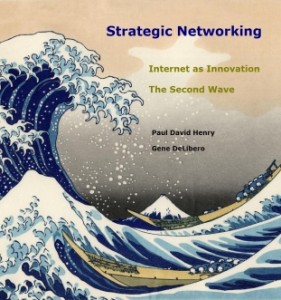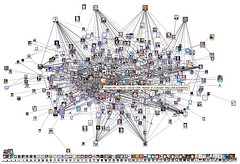In the revision of the Strategic Networking book, the emphasis is on the Internet as an innovation. By viewing the underlying technology infrastructure and the way we layer our use upon it as something that is both new and evolving, we can understand where we belong as individuals, organizations, and societies with respect to change.
By looking back at the first wave of the Internet as a disruptive technological innovation, we can better understand the game-changing and deal-changing effects it has made on traditional social and organizational norms as we began to find ways to use it to communicate, learn, and work.
The effects associated with the second wave of this innovation have been given many names (Internet 2.0, Web 2.0, the read-write Web, etc.), but it’s worth examining the nature of this wave of change as we try to adjust to where it has brought us so far, and where we might be going.
Technological innovations surface at the crest of this second wave, offering greater connectivity and reach. And social and organizational innovations rise with it to make conducting business and forming social communities a reality for all.
If we follow this technological and social change as one that shares a common path with all successful innovations, we can expect further embedding of this technology into every aspect of our lives: dynamic & growing; not merely technological, but social; not merely fixed, but mobile.
But what will this third wave bring in terms of its own innovation? That is something to ponder and plan as individuals, organizations, and society.
One thing is certain, the underlying technology of the first wave is open and scalable – ready for change and growth. And the importance of the social second wave is an inevitable outcome that will follow the path of the first wave in successive waves of growth.
From first glance it appears that with further embedding of this technology into every aspect of our lives, our use will become increasingly mobile and ambient – where objects in our natural and virtual environments merge and create a Web that reaches beyond the computer and into the streets, forests, and beaches where we roam.
Smartphones, tablets, and other mobile devices are likely to be the vanguard of many ways in which we can interact through the Internet as we walk, drive, fly, and explore our world – with each other.
What are the ways in which you envision this change? Will we recognize the Internet and the ways we now use it as a bridge to tomorrow or will new waves of technology and social change sweep through and completely redefine the ways we connect?
And as it relates to the body of knowledge on technology planned change and to our professional needs, here is a link to Strategic Networking: eBook Edition. It is available on Amazon at:
You can view the introductory chapter and part of the second chapter online in your browser by clicking on the book cover image on the left (Look inside feature).
You can also click on the Send sample now button (on right) to download a sample of the first two chapters to read on your Kindle device or other devices (other tablets, smartphone, PC, etc.) with the free Kindle software.






